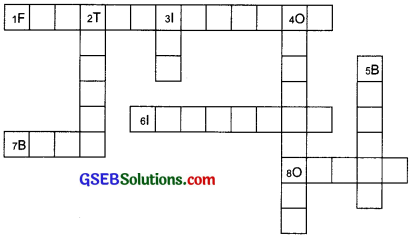Gujarat Board GSEB Textbook Solutions Class 8 Science Chapter 9 Reproduction in Animals Textbook Questions and Answers, Notes Pdf.
Gujarat Board Textbook Solutions Class 8 Science Chapter 9 Reproduction in Animals
Gujarat Board Class 8 Science Reproduction in Animals Textbook Questions and Answers
![]()
Question 1.
Explain the importance of reproduction in organisms.
Answer:
Reproduction is a very important process for the living organisms. Reproduction is essential for the continuation of a species.
Question 2.
Describe the process of fertilisation in human beings.
Answer:
In human, sexual reproduction takes place. In human beings internal fertilisation takes place. Male releases sperms inside female’s body. Sperms and ovum fuse together in fallopian tube to form zygote. During this process the nucleus of sperm fuses with the nucleus of ovum to form a single nucleus. This complete process is called fertilisation.
Question 3.
Choose the most appropriate answer:
(a) Internal fertilisation occurs
(i) in female body
(ii) outside female body
(iii) in male body
(iv) outside male body.
(b) A tadpole develops into an adult frog by the process of
(i) fertilisation
(ii) metamorphosis
(iii) embedding
(iv) budding.
(c) The number of nuclei present in a zygote is
(i) none
(ii) one
(iii) two
(iv) four
Answer:
(a) (i) in female body
(b) (ii) metamorphosis
(c) (ii) one.
![]()
Question 4.
Indicate whether the following statements are True or False.
(a) Oviparous animals give birth to young ones.
(b) Each sperm is a single cell.
(c) External fertilisation takes place in frog.
(d) A new human individual develops from a cell called gamete.
(e) Egg laid after fertilisation is made up of a single cell.
(f) Amoeba reproduces by budding.
(g) Fertilisation is necessary even in asexual reproduction.
(h) Binary fission is a method of asexual reproduction.
(i) A zygote is formed as a result of fertilisation.
(j) An embryo is made up of a single cell.
Answer:
(a) False
(b) True
(c) True
(d) False
(e) True
(f) False
(g) False
(h) True
(i) True
(j) False
Question 5.
Give two differences between a zygote and a foetus.
Answer:
Zygote:
- It contains only single cell.
- It is formed by the fusion of ovum and sperm.
Foetus:
- It contains many cells.
- It is formed by repeated divisions of zygote. Describe two methods of asexual reproduction
Question 6.
Define asexual reproduction. in animals.
Answer:
The type of reproduction in which only single parent is involved is called asexual reproduction. Asexual reproduction takes place by different methods:
(i) Budding: This process takes place in hydra and yeast. A part of organism starts bulging out. Slowly it grows and develops into a separate individual.
(ii) Binary Fission: This type of re-production takes place in amoeba. The nucleus of amoeba gets divided into two followed by division of their bodies, each part getting one nucleus. Each part developed into separate amoeba. This type of reproduction is common in unicellular organisms.
Question 7.
In which female reproductive organ does the embryo get embedded?
Answer:
In uterus.
Question 8.
What is metamorphosis? Give examples.
Answer:
The transformation of larva into an adult through drastic changes is called metamorphosis. Example: In frog and butterfly.
![]()
Question 9.
Differentiate between internal fertilisation and external fertilisation.
Answer:
The internal fertilisation takes place inside the body of female but the external fertilisation takes place outside the body of female.
In internal fertilisation, the sperms are released in female’s body by the male while in external fertilisation sperms are released in open like in water.
Question 10.
Complete the crossword puzzle using the hints given below:
Across:
1. The process of the fusion of the gametes.
6. The type of fertilisation in hen.
7. The term used for bulges observed on the sides of the body of hydra.
8. Eggs are produced here.
Down:
2. Sperms are produced in these male reproductive organs.
3. Another term for in vitro fertilization.
4. These animals lay eggs.
5. A type of fission in amoeba.

Answer:
